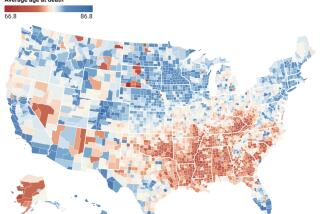Premature birth has long-lasting effects
- Share via
Infants born prematurely are much more likely to die during childhood and, if they survive, much less likely to have children of their own in adulthood, according to the largest study of prematurity ever undertaken.
Researchers already knew that premature infants faced many neurological and developmental problems, but the findings reported today indicate that the spectrum of problems is even broader than suspected and persists throughout the child’s lifetime.
The study, conducted using Norwegian birth data, suggests that as the percentage of premature infants who make it through their first year continues to grow because of advances in neonatology, the number of troubled infants and adults will also rise.
“Are we improving their survival at the expense of significant problems down the road?” asked the lead author, Dr. Geeta Swamy of Duke University Medical Center.
Experts said the situation is probably worse in the United States.
“Norway demonstrates better outcomes than the United States, which has persistent, stark racial disparities” in care for the premature, wrote Melissa M. Adams of RTI International in Atlanta and Dr. Wanda D. Barfield of the Centers for Disease Control and Prevention in an editorial accompanying the report in the Journal of the American Medical Assn.
One in eight American infants is now born prematurely, more than half a million per year, despite the best efforts of physicians to bring more pregnancies to full term -- defined as 38 weeks or longer.
Researchers are not sure why the rate is so high, but contributing factors include the growing incidence of assisted reproduction, which often produces twins or triplets, which are more likely to be born prematurely.
Also on the rise are deliberately induced premature deliveries and cesarean sections -- many because of distress to the mother or infant, but some for the convenience of the doctor or mother.
The consequences can be devastating, particularly for very early births. They include learning disabilities, neurological problems, lung diseases and cerebral palsy.
Using Norway’s extensive registry of births and medical care, Swamy and her colleagues studied all 1,167,506 singleton births in that country between 1967 and 1988, following the children through 2002. They also looked at educational achievement and reproduction in the group born between 1967 and 1976.
A total of 5.2% of the births were premature, less than half the percentage in the U.S.
For boys born the most prematurely, between 22 and 27 weeks, the risk of death was 5.3 times normal between the ages of 1 and 6 and seven times normal between 7 and 13. For boys born between 28 and 32 weeks, the risk of death was 2.5 times normal in early childhood and 2.3 times normal in late childhood.
The most premature girls had 9.7 times the normal risk of death between the ages of 1 and 6 but no increased risk between 7 and 13. Girls born between 28 and 32 weeks did not have any significantly increased risk of death.
The investigators are not sure what accounts for the increased risk, but some of it is due to cancer and congenital abnormalities, Swamy said.
In adulthood, boys born the most prematurely were 76% less likely to reproduce, with only about one in seven having children. Women who had been the most prematurely born were 67% less likely to reproduce, with about one in four having children.
The lower rate of reproduction can be attributed to both the medical problems produced in some adults by prematurity and the typically lower socioeconomic status resulting from those problems.
Preterm women, but not preterm men, were at increased risk of having premature offspring.
Those born prematurely were also significantly less likely to finish high school or complete college.
--






